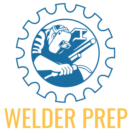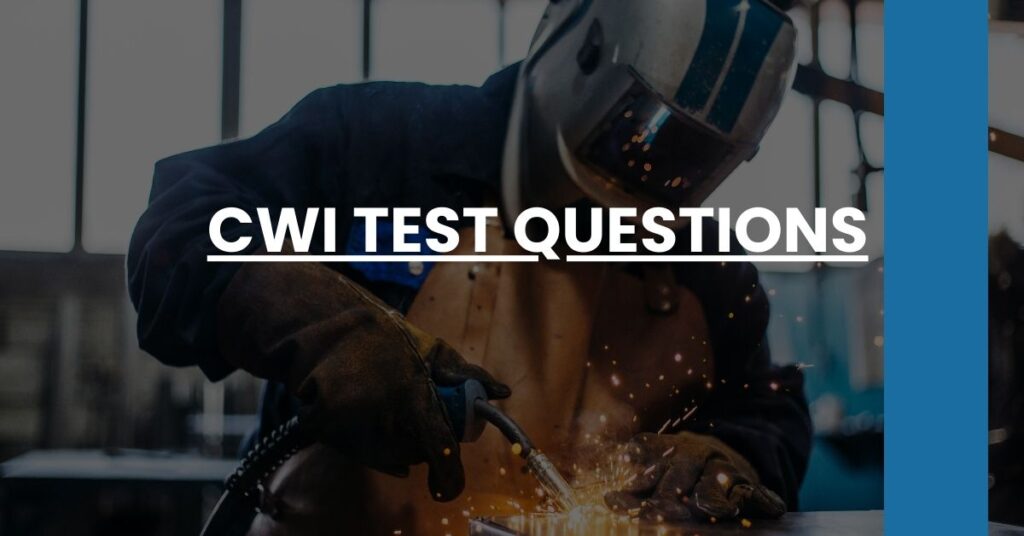Preparation for the CWI test questions is crucial for any aspiring welding inspector. Here’s what you need to know:
- Understand the CWI exam structure: Learn about the three parts—Fundamentals, Practical, and Code Book.
- Focus on key areas: Study welding processes, inspection techniques, and safety protocols.
- Practice sample questions: Gain confidence with mock tests and hands-on practice.
Master the CWI test questions, and you’ll enhance your expertise and career prospects.
Understanding the CWI Exam
The CWI (Certified Welding Inspector) exam is a highly respected certification that ensures the candidate’s proficiency in evaluating welding operations and upholding quality standards across industries. The exam is divided into three main sections: Fundamentals, Practical, and Code Book. Let’s break down what each section entails.
Part A: Fundamentals
Part A of the CWI exam focuses on general welding knowledge. This section assesses your understanding of critical topics:
- Welding Processes: You should be familiar with various welding processes such as Shielded Metal Arc Welding (SMAW), Gas Metal Arc Welding (GMAW), Gas Tungsten Arc Welding (GTAW), and others. Each process has its unique applications and techniques.
- Safety Protocols: Safety is paramount in welding. Expect questions on personal protective equipment (PPE), safe handling of welding equipment, and the correct procedures to prevent accidents.
- Welding Terminology: Mastery of welding vocabulary is crucial. Terms related to different weld types, positions, and defects are commonly tested.
- Basic Techniques: Concepts such as heat transfer, weld joint designs, welding symbols, preheating, and post-weld heat treatment should be well understood.
Properly preparing for Part A involves studying welding principles, reviewing relevant textbooks, and practicing with sample questions.
Part B: Practical
Part B tests your hands-on inspection skills. This section evaluates how well you can apply theoretical knowledge in practical scenarios:
- Visual Inspection: Your ability to visually detect defects and discontinuities in weld samples is crucial. You’ll need to identify issues like cracks, porosity, and undercut.
- Welding Symbols: Interpreting welding symbols on blueprints is a common element. Accurate interpretation of these symbols ensures a correct understanding of welding requirements.
- Inspection Tools: Proficiency in using inspection tools is necessary. You should be comfortable with fillet weld gauges, micrometers, and other measurement devices.
Hands-on practice with actual weld specimens, alongside training in the use of inspection tools, will aid significantly in this part of the CWI exam.
Part C: Code Book
Part C requires adeptness in navigating and applying information from welding code books such as:
- AWS D1.1 (Structural Welding Code – Steel): This code covers key standards for welding steel structures, commonly used in construction and manufacturing.
- API 1104 (Welding of Pipelines and Related Facilities): This code provides specifications for welding pipelines, essential for industries like oil and gas.
Your ability to quickly locate information and understand codebook specifications is critical. Familiarize yourself with the format and sections of these codebooks through extensive practice.
Key Areas of Focus
Welding Processes
In the CWI exam, understanding various welding processes is fundamental. You should be acquainted with:
- Shielded Metal Arc Welding (SMAW): This process uses a consumable electrode coated in flux to lay the weld.
- Gas Metal Arc Welding (GMAW): Also known as MIG welding, GMAW uses a continuous wire feed as an electrode.
- Gas Tungsten Arc Welding (GTAW): Also known as TIG welding, GTAW uses a non-consumable tungsten electrode to produce the weld.
- Flux-Cored Arc Welding (FCAW): Similar to GMAW but uses a tubular wire filled with flux.
You must know the advantages, limitations, and applications of each process.
Welding Codes and Standards
Knowledge of welding codes and standards is crucial for ensuring compliance with industry requirements:
- AWS D1.1: Essential for structural steel welding, it covers acceptable practices and requirements for weld quality.
- API 1104: Critical for pipeline welding, it outlines procedures and acceptance criteria to ensure pipeline integrity.
Spend time understanding the purpose and scope of these codes to navigate them effectively during the exam.
Inspection Techniques
Proficiency in various inspection techniques is critical for detecting and evaluating weld quality:
- Visual Testing (VT): This is the most basic and widely used inspection method. It involves a direct visual examination of the welds.
- Non-Destructive Testing (NDT): Techniques such as ultrasonic testing, radiographic testing, and magnetic particle testing to detect internal flaws without damaging the weld.
Improving your practical skills through hands-on training and practice is essential to master these techniques.
Welding Metallurgy
Understanding the behavior of metals during welding helps in predicting and preventing defects:
- Thermal Expansion: Understanding how metals expand and contract with heat to avoid issues like distortion.
- Phase Transformations: Knowing how different metals and alloys change phases during heating and cooling.
- Common Defects: Awareness of defects like cracking, slag inclusion, and porosity.
Enhance your knowledge of welding metallurgy to handle these issues effectively.
Safety Protocols
Safety is paramount in any welding environment. CWI candidates must adhere to stringent safety standards:
- Personal Protective Equipment (PPE): Proper use of helmets, gloves, and protective clothing.
- Hazard Recognition: Identifying risks like fumes, radiation, and electrical hazards.
- Safe Practices: Implementing safe working practices and emergency procedures.
Commit to learning and applying safety protocols to ensure a secure working environment.
Types of Questions in the CWI Exam
Multiple-choice Questions
Multiple-choice questions form a significant portion of the CWI exam. These questions assess your theoretical knowledge:
- Example Question: “What is the primary purpose of a Welding Procedure Specification (WPS)?” Such questions test your understanding of processes and safety standards.
Practical Questions
Practical questions evaluate your ability to analyze real-world weld samples:
- Example Question: “Identify the type of discontinuity shown in this weld sample.” Practical questions require visual assessment skills and familiarity with different defect types.
Time-limited Tasks
The exam includes time-limited tasks to test your efficiency:
- Task Example: Measuring a weld bead’s thickness using a fillet weld gauge within a specified time. These tasks assess your speed and accuracy in performing inspections.
Practice with sample tests and physical samples to improve your response time and inspection skills.
Sample CWI Test Questions
Fundamentals (Part A)
- Which welding process uses a non-consumable tungsten electrode?
- Answer: Gas Tungsten Arc Welding (GTAW).
- What is the primary purpose of a Welding Procedure Specification (WPS)?
- Answer: To provide detailed instructions on achieving a specific weld.
Practical (Part B)
- Identify the type of discontinuity shown in this weld sample.
- Answer: Porosity.
- Interpret the welding symbol depicted in the following diagram.
- Answer: The symbol indicates a groove weld with a 45-degree bevel preparation.
Code Book (Part C)
- According to AWS D1.1, what is the maximum allowable undercut for a fillet weld?
- Answer: 1/32 inch.
- How does API 1104 define the acceptance criteria for porosity in pipeline welding?
- Answer: The size and frequency of allowable pores depend on the pipeline’s service category.
These sample questions illustrate the range and depth of topics you need to master to succeed in the CWI exam. Thorough preparation and practice are key to achieving your certification.
Strategies for Answering CWI Test Questions
To excel in the CWI test questions, you need a strategic approach. Effective strategies can significantly boost your efficiency and accuracy. Here are some tried-and-true methods to tackle the exam:
Time Management
Proper time management is crucial. The CWI exam requires you to handle multiple aspects within a limited timeframe. Break down your time as follows:
- Allocate Time Based on Complexity: Spend more time on complex questions and less on straightforward ones.
- Practice Timed Tests: Regularly engage in timed practice tests to build speed and confidence.
- Set Milestones: Divide the exam into sections and set time limits for each.
Time management ensures that you don’t linger too long on any single question, allowing you to address all parts of the exam efficiently.
Thorough Reading
Before you answer, make sure you thoroughly understand each question:
- Read Carefully: Ensure you grasp the question’s requirements and nuances.
- Identify Key Terms: Highlight crucial terms and instructions within the question.
- Analyze Options: For multiple-choice questions, evaluate all options before selecting the best one.
Thorough reading minimizes the risk of misinterpretation and enhances the accuracy of your answers.
Using Process of Elimination
The process of elimination can help you navigate multiple-choice questions more effectively:
- Eliminate Wrong Answers: Cross out options that are clearly incorrect.
- Focus on Remaining Choices: Concentrate on the remaining options, further narrowing them down based on your knowledge.
This strategy increases your chances of selecting the correct answer by removing distracting and incorrect choices.
Practice Practical Skills
Practical skills are vital for the CWI exam. Here’s how to hone them:
- Hands-on Practice: Regularly work with weld samples to identify defects and discontinuities.
- Tool Familiarization: Get accustomed to using key inspection tools like fillet weld gauges and micrometers.
- Mock Inspections: Perform mock inspections of weldments to simulate exam conditions.
Dedication to practical skills ensures that you can confidently answer practical questions on the exam.
Familiarize with Codebooks
Navigating codebooks efficiently is essential for Part C of the CWI exam:
- Regular Reading: Spend time reading and understanding the key sections of codebooks like AWS D1.1 and API 1104.
- Quick Reference: Practice locating information quickly to save time during the exam.
- Understand Applications: Know how and when to apply different codebook sections.
This preparation will help you handle codebook-related questions swiftly and accurately.
Common Pitfalls and How to Avoid Them
Overlooking Details
One common mistake is overlooking critical details. Always:
- Read Questions Fully: Ensure you understand every aspect of the question.
- Double-check Answers: Verify your answers against the question requirements.
Poor Time Management
Time management is often neglected. Avoid this pitfall by:
- Practicing Timed Sessions: Regular timed practice builds an intuitive sense of pacing.
- Prioritizing Questions: Answer less complex questions first to secure easy marks.
Lack of Practical Experience
Practical experience is irreplaceable. Make sure to:
- Engage in Regular Practice: Consistent practice with real weld samples.
- Attend Workshops: Participate in workshops or training sessions to get hands-on experience.
Neglecting Codebooks
Some candidates overlook the importance of codebooks. Prevent this by:
- Studying Intensively: Spend significant time understanding the codebooks.
- Using Tabs: Tab key sections for quick reference during the exam.
Ignoring Basic Concepts
Weakness in fundamental welding concepts can be detrimental. To avoid:
- Review Basics Regularly: Keep revisiting basic principles and techniques.
- Practice Basics in Different Scenarios: Apply basic concepts in various practical scenarios.
Avoiding these common pitfalls increases your likelihood of success in the CWI exam.
Resources for CWI Test Preparation
To ace the CWI exam, tap into the following resources:
Books
- “Welding Inspection Technology” by AWS: This textbook offers comprehensive coverage of welding inspection principles and practice problems.
Online Courses
- Udemy online courses and Coursera welding courses: These platforms offer detailed courses tailored to the CWI exam, including video lessons and interactive modules.
Practice Tests
- AWS Practice Exams: These practice exams simulate the actual test conditions, helping you get familiar with the format and question types.
Workshops
- CWI preparatory workshops: Many institutions provide workshops specifically aimed at the CWI exam. These include hands-on practice and expert guidance.
Study Groups
- Join Study Groups: Collaborate with peers to discuss challenging topics and share study materials. Study groups provide moral support and additional insights.
Leverage these resources to build a robust preparation strategy, crucial for passing the CWI exam.
Conclusion
To sum up, preparing for the CWI test questions requires a detailed approach. By focusing on time management, thorough reading, practical skills, and codebook familiarity, you’ll be well on your way to achieving CWI certification. Avoid common pitfalls by paying attention to details, managing time wisely, gaining practical experience, and understanding codebooks thoroughly. Utilize all available resources, from books and online courses to practice tests and workshops. With these strategies, you can confidently approach the CWI exam and secure your certification.

